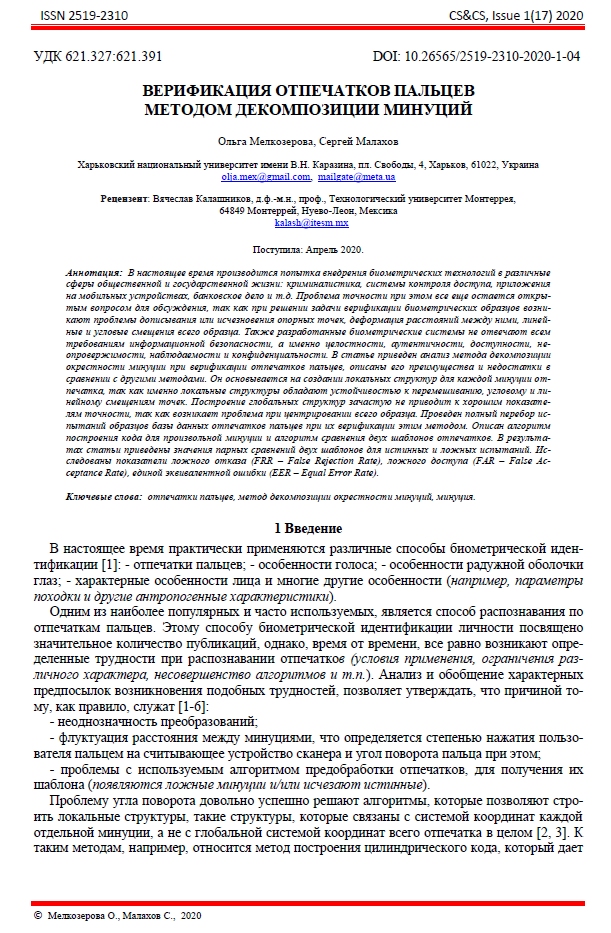Fingerprint verification by the method of minutia decomposition
Abstract
Currently, an attempt is being made to introduce biometric technologies in various spheres of public and state life: forensics, access control systems, applications on mobile devices, banking, etc. The problem of accuracy remains an open question for discussion, because when solving the problem of verification of biometric samples there are problems of addition or disappearance of reference points, deformation of distances between them, linear and angular displacements of the whole sample. Also, the developed biometric systems do not meet all the requirements of information security, namely the integrity, accessibility, authenticity, indisputability, observability and confidentiality. The article presents an analysis of the method of decomposition of minefields during fingerprint verification, describes its advantages and disadvantages in comparison with other methods. It is based on the creation of local structures for each minute of the imprint, because it is the local structures that are resistant to mixing, angular and linear displacement of points. Building global structures often does not lead to good accuracy, as there is a problem of centering the entire sample. A complete list of tests of samples of the database of fingerprints during their verification by this method. An algorithm for constructing a code for an arbitrary minution and an algorithm for comparing two sample templates are described. The results of the article show the value of pairwise comparisons of two templates for true and false tests. The indicators of false rejection rate (FRR), false access rate (FAR), single equivalent error rate (EER) were studied.
Downloads
References
Lantian Li, Chao Xing, Dong Wang, Kaimin Yu, Thomas Fang Zheng, Binary Speaker Embedding, In arXiv:1510.05937v2 31 Mar 2016. https://ieeexplore.ieee.org/document/7918381 - 20.06.2020.
Jin Zhe, Andrew Teoh Beng Jin, Fingerprint template protection with Minutia Vicinity Decomposition. Article, 2011. https://www.researchgate.net/publication/261431544_Fingerprint_template_protection_with_Minutia_Vicinity_Decomposition - 20.06.2020.
Wajih Ullah Baig, Umar Munir, Waqas Ellahi, Adeel Ejaz, Kashif Sardar Minutia texture cylinder codes for fingerprint matching https://arxiv.org/pdf/1807.02251.pdf , Article 2018 - 20.06.2020.
Melkozerova, O., Shlokin, V., Malakhov, S. Mathematical model of the biometric system of fingerprint authentication. Problems of informatization: abstracts of the reports of the seventh international conference on November 13-15, 2019, Pages. 92.
Melkozerova, O., Malakhov, S. Features of automated software testing procedures. Problems of informatization: abstracts of the reports of the seventh international conference on November 13-15, 2019, Pages 36.
Melkozerova, O., Rassomakhin, S. Identification of fingers on the basis of Hamiltonian cycles of local features. the Bulletin of KNU Series "Mathematical Modeling. IT. ACS". Bulletin of V. Karazin Kharkiv National University series «Mathematical Modelling. Information Technology. Automated Control Systems». 2019. Issue 44. Pages 51–65. https://periodicals.karazin.ua/mia/article/view/15767 - 20.06.2020.


